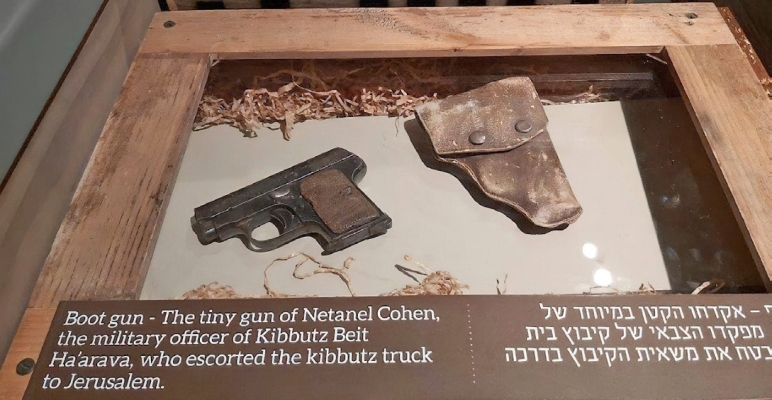Khan Museum at Shaar Hagai, Jerusalem
A large – and until recently – sadly dilapidated but still attractive ruin of an Ottoman Khan (caravanserai) is situated meters from the main approach road to Jerusalem at Shaar Hagai. It has been renovated and is nowadays a highly informative, interactive museum, concentrating on one of the most fiercely fought battles of the 1948 War of Independence.
Deeply emotional and thought-provoking, the exhibits on display in the renovated Turkish-built white stone building are arranged in showcases under the attractive original high-arched ceilings with additional thick wooden beam supports. These exhibits leave the visitor utterly amazed at the against-all-odds achievements and the tragically high cost in lives of the brave, but ill-equipped Jewish fighters, struggling to get through a treacherously narrow major artery passage to break the prolonged Arab siege of Jerusalem.
Although well-documented and the subject of many a cinematic film and television historical docu-series, a visit to the Khan Shaar Hagai Museum deepens one's understanding of, and awe at, the sheer determination of the ill-prepared soldiers, some of whom were only in their early teens. They were ready to pay with their lives in order to attain the ultimate goal of capturing the jugular vein leading to the City of Gold, releasing the Arab stranglehold and bringing food and water to the besieged, suffering and desperate city residents.
Built in the late 1800s, the khan served pilgrims, travelers and immigrants making their way – many having disembarked at the port of Jaffa – to Jerusalem. In present times, film interviews with elderly survivors of the battle for Bab el Wad, as the narrow pass is known in Arabic, animated films and sepia photographs are shown on a ceiling-high screen. Through large windows, visitors can see the present-day traffic whizzing by just meters away on the very road so bitterly fought for, and this brings home even more the absolute strategic importance of Shaar HaGai (the gate to the valley), as it is called in Hebrew then and in present times.
Visitors are not only whisked back in time, but also encouraged to participate at interactive stations tussling with the then logistics, life and death decision-making faced by the soldiers' commanders at the height of battle, such as should the armored trucks and buses be loaded with water, food and medicines – or much needed by those inside trying to defend the city – weapons and ammunition.
Going from one station to another, picking up black phones similar to those on the original field phone sitting on a table alongside, one is given details of the quandary. Whilst listening to the dilemma being dealt with, for just a few moments one feels the huge weight of responsibility in making such enormous decisions under fire, without the necessary information or time to make the best decision.
An experience never to be forgotten follows … entering what looks like the insides of one of the armored trucks. People sit on hard benches, with only slits in the metal walls and iron bars to cling on to, when suddenly it starts rattling, rolling and shaking – with sounds of gunfire, screams and other background sounds associated with being in the center of the actual events almost eight decades ago.
Coming out into the open air, those sounds are replaced by the noise of modern day traffic on the multi-lane highway that the narrow pass has become in present times. A number of renovated vehicles, including an original Egged bus, truck and ambulance, are parked one after the other, with information boards, also showing original photos, displayed alongside each vehicle.
The Khan Shaar Hagai Museum and Heritage Center, a project of the Israel Nature & Parks Authority, not only tells the story of the famous battle of the convoys to release Jerusalem, but in a most innovative and challenging fashion, perpetuates the memory and heritage, the bravery and dedication, of all those who fought for the establishment of the State of Israel and in the War of Independence in 1948.










Comments